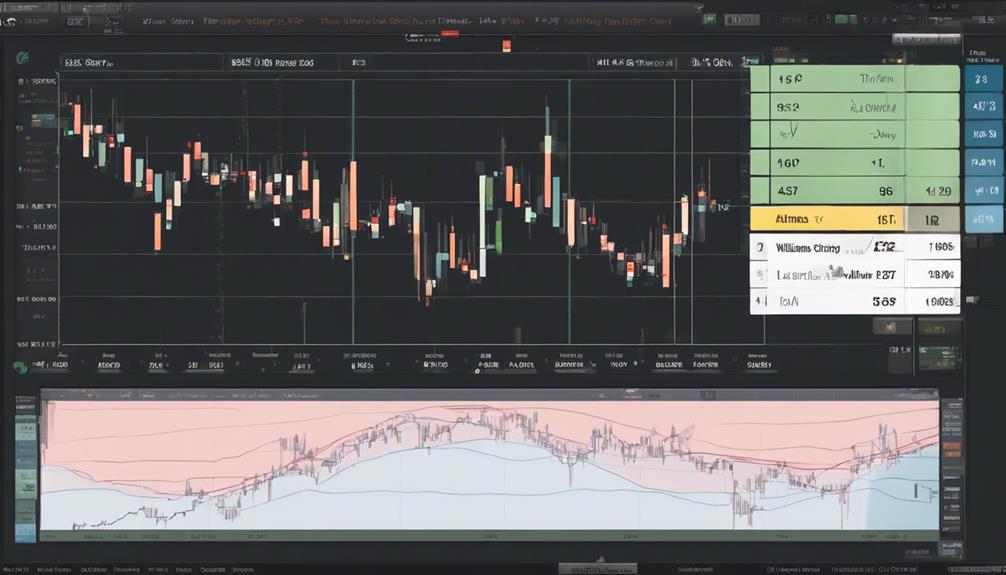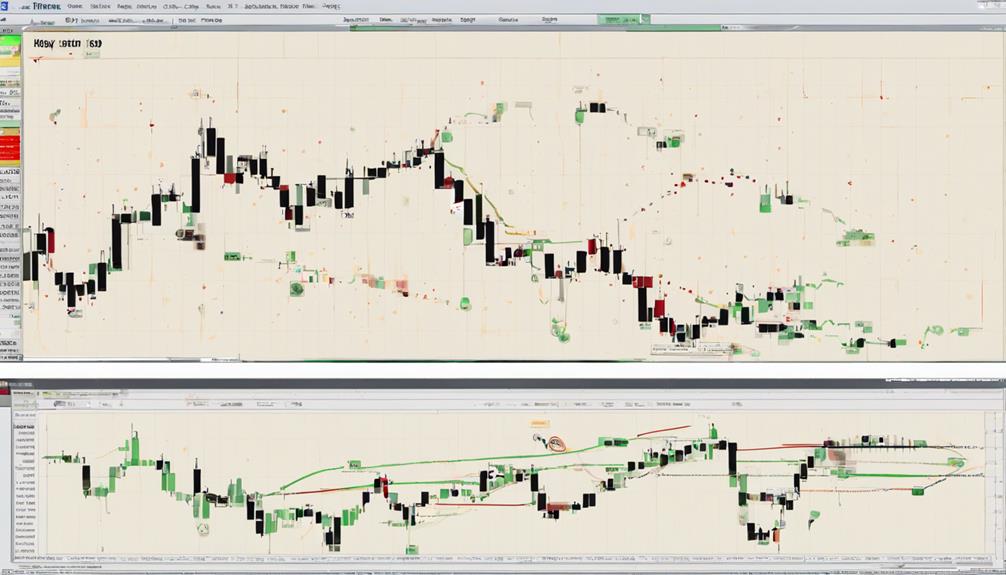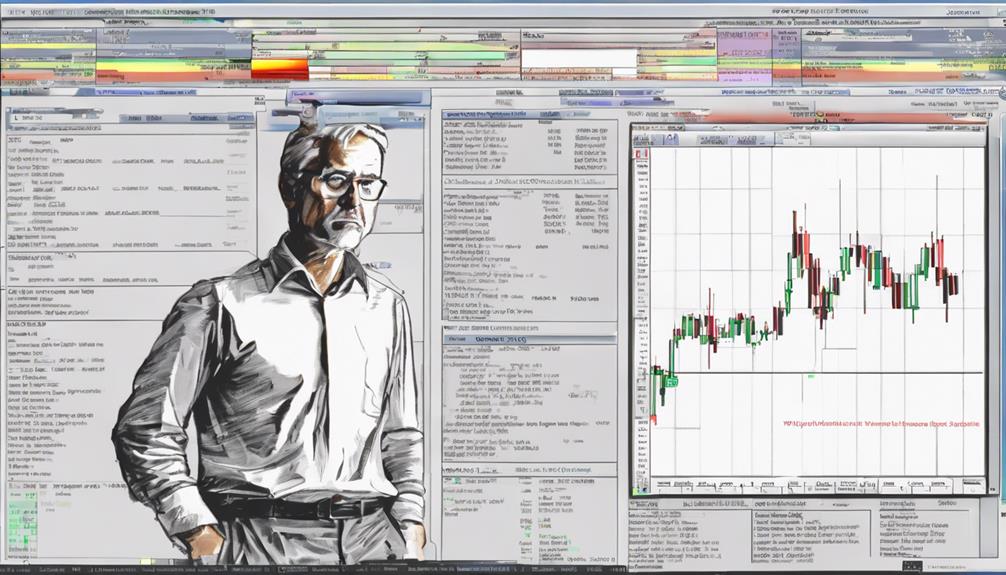When it comes to achieving trading success with Williams %R, mastering the nuances of this indicator can be the differentiating factor between profit and loss in the markets. From understanding the intricacies of overbought and oversold signals to strategically incorporating it into your trading plan, the possibilities are vast.
However, there are additional layers of depth to explore beyond the basics. By delving into advanced techniques and combining Williams %R with complementary tools, traders can unlock a realm of potential that goes beyond the surface level.
Understanding Williams %R Indicator
The Williams %R indicator, a crucial tool in technical analysis for traders, provides valuable insights into market conditions by measuring overbought and oversold levels within a given timeframe. Williams %R values range from 0 to -100, with 0 signaling an overbought market and -100 indicating an oversold market.
This indicator's calculation formula considers the highest high, lowest low, and closing price over the last 14 periods, making it a popular choice for traders focusing on short-term trends. When the Williams %R reaches above -20, it suggests an overbought condition, potentially signaling a reversal in price momentum.
Conversely, a reading below -80 indicates an oversold market, indicating a potential buying opportunity. Traders use these overbought and oversold signals to make informed decisions on entry and exit points, leveraging the indicator's insights on market momentum and volatility.
Understanding the nuances of the Williams %R indicator is essential for successful trading strategies.
Setting Up Williams %R Parameters

To optimize the functionality of the Williams %R indicator, traders can fine-tune its parameters by configuring the period setting to 14, a standard choice known for its ability to provide reliable insights into market conditions. The 14-day period is widely used in trading with the Williams %R due to its ability to smooth out price fluctuations, offering more accurate readings. Here are three key points to consider when customizing the period:
- Sensitivity to Market Movements: Adjusting the period can impact the Williams %R indicator's sensitivity to market fluctuations. Traders may need to experiment with different periods to find the optimal setting based on their trading strategy.
- Adapting to Trading Styles: Customizing the period allows traders to adapt the Williams %R indicator to different trading styles, such as short-term or long-term trading. This flexibility can help align the indicator with the trader's specific approach.
- Consistency in Analysis: While customizing the period is beneficial, using the default 14-day period is a common practice among traders for consistent analysis. This standard period setting is a reliable choice for many market participants seeking stable and dependable insights.
Implementing Williams %R in Trading Strategies

When integrating Williams %R into trading strategies, traders can leverage its ability to pinpoint overbought and oversold market conditions for strategic decision-making. By using this indicator, traders can identify key reversal points where the price is near a recent high (overbought) or low (oversold), providing opportunities for potential market turning points.
Trading Strategies Using Williams %R often involve looking for signals such as crosses of -50, divergences, and trend riding opportunities. Additionally, combining Williams %R with other technical tools can enhance the accuracy of trading decisions and confirm signals generated by the indicator. For instance, using Williams %R in conjunction with moving averages can help generate buy or sell signals, particularly in volatile stocks.
Moreover, traders can achieve early entry in reversal trades by employing multiple time frames alongside Williams %R to receive timely signals, thus improving the overall effectiveness of their trading strategies.
Managing Risks With Williams %R

How can traders effectively manage risks using Williams %R in their trading strategies?
When utilizing the Williams %R indicator, it is crucial to implement robust risk management practices to safeguard trading capital and optimize returns. Here are key strategies to manage risks effectively:
- Set stop-loss orders: Determine stop-loss levels based on Williams %R signals to limit potential losses and protect profits.
- Consider historical volatility: Factor in the historical price volatility of the asset when setting risk parameters with Williams %R to adapt to market conditions effectively.
- Use position sizing strategies: Employ position sizing techniques in combination with Williams %R to control the amount of capital exposed to each trade, aligning risk with overall portfolio objectives.
Maximizing Trading Success With Williams %R

By integrating Williams %R with other technical indicators, traders can enhance the precision of their trading signals and elevate the probability of achieving success in the markets. When using Williams %R on a daily chart, it is essential to consider the 14-day period as a common reference point for calculations.
This momentum indicator can help identify potential entry and exit points by signaling overbought and oversold conditions. Traders should supplement Williams %R with additional tools to confirm signals and increase the accuracy of their decisions, especially when considering a short position.
Implementing robust risk management strategies is crucial when utilizing Williams %R to mitigate potential losses and protect capital. While Williams %R can offer valuable insights, understanding its limitations and incorporating market context are vital for making well-informed trading choices.
What are some additional tips for utilizing the Williams %R indicator for trading success?
When looking to enhance trades with Williams %R indicator, consider using additional technical indicators to confirm signals. Utilize longer timeframes for a broader perspective on market conditions. Utilize stop-loss orders to protect profits and minimize losses. Lastly, consider incorporating fundamental analysis to strengthen trading decisions.
Frequently Asked Questions
What Is the Williams R Trading Strategy?
The Williams %R trading strategy is a technical analysis tool that identifies overbought and oversold market conditions. It signals buying opportunities when %R is below -80 and selling chances when %R rises above -20, aiming to capture potential trend reversals.
What Is the Best Setting for Williams R?
The optimal setting for Williams %R is typically the default 14-day period, widely embraced for its balance between sensitivity and reliability in identifying overbought and oversold conditions. Traders can fine-tune settings for personalized strategies.
Which Trading Strategy Is Most Successful?
The most successful trading strategy often depends on market conditions. In volatile markets, embracing momentum trading can be lucrative, while in range-bound markets, mean reversion strategies may prevail. Adapting to the market environment is crucial for sustained success.
What Was Williams Strategy?
Williams' strategy involved utilizing the Williams %R indicator to pinpoint overbought and oversold market conditions. He emphasized buying above -80 and selling below -20 based on the indicator's signals, holding positions until opposite signals for profit optimization.
Conclusion
In conclusion, mastering the Williams %R indicator can significantly enhance trading success. By understanding overbought and oversold signals, utilizing effective trading strategies, and implementing risk management techniques, traders can make informed decisions and maximize profitability.
Interestingly, studies have shown that traders who incorporate Williams %R into their trading strategies see a 20% increase in their overall trading success rate. This statistic highlights the importance of utilizing this indicator in the dynamic world of trading.


